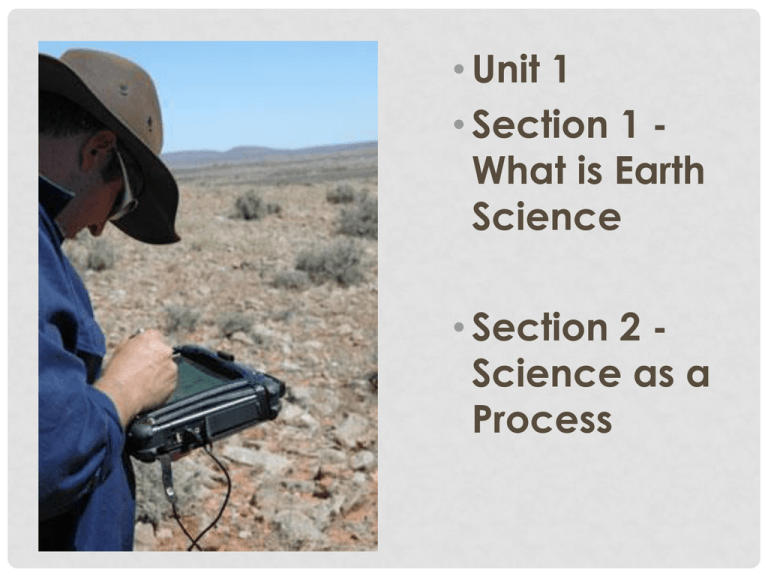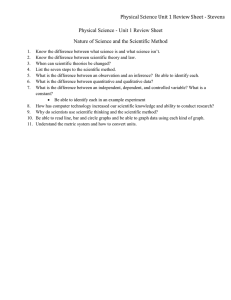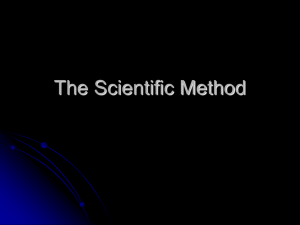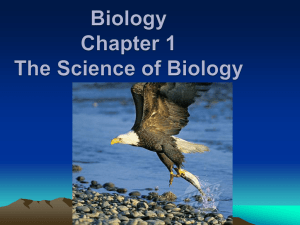Welcome to Earth Science chapter 1
advertisement

• Unit 1 • Section 1 What is Earth Science • Section 2 Science as a Process HISTORY OF EARTH SCIENCE STUDY • China – 780 BCE kept records of earthquakes • Ancient Greece – 200 BCE compiled catalog of rocks and minerals • Maya 4000+ years ago created accurate calendars by observing the sun, stars, and moon. • Earth scientists help us better understand the world around us by studying how natural forces shape our environment. They do this by making observations and inferences. • Observation - Process of collecting information by using the senses OBSERVATIONS CAN BE QUANTITATIVE OR QUALITATIVE • Quantitative - observation with numbers • Qualitative – Observations about characteristics. E.g. color INTERNATIONAL SYSTEM OF UNITS FOR QUANTITATIVE MEASUREMENTS Measurement measures Instrument used SI unit Volume How much space an object takes up Graduated cylinder/beaker Cm3 or liter Length How long an object is Ruler/measuring tape meter Mass The amount of matter in an object Triple beam balance grams Temperature Amount of heat thermometer celcius Density D=M/V How much matter is in a given space Graduated cylinder/triple beam balance g/l or g/cm3 MODELS • Model – A representation to show how an object, system, or concept works. 1. Physical – Models you can touch. 2. Graphical – Maps and charts 3. Mathematical – Made of math equations. 4. Conceptual – Illustration to support a hypothesis. STATIONS • You will have 5 minutes at each station. • Make five observations about each object. Determine if the observation is qualitative or quantitative. • Do not move to the next station until the timer goes off. Earth Science – study of Earth and its universe Geology – study of Earth structure And history Meteorology – study of Atmosphere Oceanography – Study of the ocean Astronomy – study of The universe Geologists Meteorologist Oceanographer Astronomers Volcanologists – study volcanoes Paleontologists – Study fossils Seismologists – study earthquakes Other scientists who study Earth science include environmental scientists, ecologists, geochemists, cartographers. WHAT IS THE DIFFERENCE BETWEEN A THEORY AND A LAW? • Theory – A system of ideas explaining many related observations and supported by scientific investigation. A theory gives an explanation of why something happens. A THEORY WILL NEVER BECOME A LAW! • Law – A general statement that explains how the natural world behaves. Does not answer “why”. It states what happens every time. Ex: Law of gravity. SCIENCE CAN IMPACT SOCIETY • By creating new technology • But may also create problems How is science different? • Science is different from other forms of human endeavor because the goal of science is to explain natural phenomena. • Earth scientists assume that the causes of natural events or phenomena can be determined by careful observation and experimentation. • Hypothesis – Testable idea or explanation that leads to scientific investigation. EXPERIMENTAL DESIGN All experiments must have an independent variable, a dependent variable, and a control group. Independent variable – Factor manipulated in an experiment. The “if” part of the hypothesis. Dependent variable – Factor that changes because of the independent variable. The “then” part of the hypothesis. Control group – Test group not subjected to the independent variable. Normal conditions FOR EXAMPLE Example: What effect does blue light have on plant growth? Hypothesis? Independent variable? Dependent variable? Control group? PRECISION AND ACCURACY LAB SAFETY • Pages FL32-FL35




